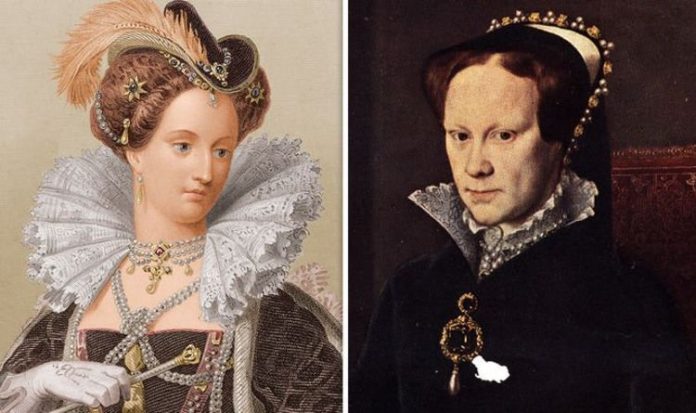Elizabeth I: Lucy Worsley discusses ‘middle way’ with religion
Elizabeth, the youngest daughter of King Henry VIII, is history’s Virgin Queen who famously saw off the Spanish Armada and encouraged the Renaissance. Her success as a monarch is considered remarkable, partly because of the contrast with her predecessors. Her father Henry died after a chaotic life on the throne — he had six wives and split from Rome, creating the Church of England, in just three and a half decades — leaving the crown to his Protestant son, Edward VI.
But he died at just 15 and so the throne fell to his oldest sister, Mary, daughter of Catherine of Aragon.
She was determined to overturn the English Reformation and the dominance of Protestantism by reverting the state religion back to Catholicism — meaning she resorted to burning 280 religious objectors at the stake.
After her five-year reign, she died childless, leaving the throne to her half-sister Elizabeth.
Having witnessed the turmoil switching between religions had brought upon the land, Henry’s second daughter tried to tow a more central path and permit elements of both religious practices.

Queen Elizabeth I and her half-sister and predecessor, Queen Mary I (Image: Getty)

The Tudor era oversaw the Reformation, as the state religion swung between Protestantism and Catholicism (Image: Getty)
However, in 1570, the Pope started to encourage his supporters to invade England and replace Elizabeth with her Catholic cousin, Mary, Queen of Scots.
Historian Jessie Childs explained: “Pope Pius V excommunicated Elizabeth I, so he declares her a heretic, he says she’s illegitimate and says she’s a usurper, a monster-like usurper.
“And he orders her subjects, her Catholic subjects, to disobey her.
“So what Elizabeth’s Privy Council comes up with is something that is known as the Bloody Question.”
READ MORE: Royal Family LIVE: How Prince Harry ‘doomed’ Meghan’s royal future

King Henry VIII split from the Pope primarily so he could obtain a divorce (Image: Getty)
This question was: “If the Pope backs an invasion of England to restore the Catholic faith to England, who are you going to support?
“Are you going to support the Pope or are you going to support the Queen?”
Ms Childs continued: “It’s very tough for the Catholics because now they’ve suddenly got really, the choice of two betrayals.”
The historian said to betray the Pope would be to condemn your soul to damnation forever, while betraying the Queen would mean your body is subjected to physical punishment.
This intensified in the 1580s when England was at war with Spain.
Catholic priests were perceived as potential traitors — those ordained abroad who then tried to enter England could expect to be “hung, drawn and quartered” — as could any citizen who hid or protected the priests.
DON’T MISS
Princess Beatrice’s surprise connection to lookalike Queen Victoria [INSIGHT]
Royal mystery surrounding ‘shape-shifting’ Anne Boleyn unravelled [EXPLAINED]
Philip’s romance with Queen summed up as Duke ‘just like George VI’ [EXPOSED]

Elizabeth I deemed Catholic priests ‘traitors’ (Image: Getty)

The Pope threatened to give Elizabeth’s throne to Mary, Queen of Scots – a Catholic (Image: Getty)
Speaking on the BBC’s ‘Royal History’s Biggest Fibs with Lucy Worsley’, Ms Childs said: “This is not a golden age for the Catholics.”
There were also sadistic priest hunters who preyed upon Catholics.
The monarch did not want to be associated with such illegal killings, but Elizabeth was reportedly aware they were in operation.
Ms Childs even claimed there were some letters sent to the hunters where the Queen let them know she was pleased with their actions.
She explained: “If we’re looking at the bloody balance sheet, about 300 people are burnt during Mary I’s reign, in a short period of time, a few years.”
During Elizabeth’s reign, approximately 200 people were executed — but arguably being hung, drawn and quartered was a more painful and macabre way to die.

Mary I was famous for burning religious dissenters at the stake (Image: Getty)
Ms Childs claimed in HistoryExtra.com: “Torture was used more than in any other English reign.”
Additionally, Elizabeth was careful to convict the priests as traitors.
History.com explained: “While people could dispute religious belief, no one could ever possibly agree that treason was permissible.”
Elizabeth’s supposed success was also cemented by propaganda.
As the nation stayed Protestant after her death, history remembered her favourably, especially in comparison to her sister.







